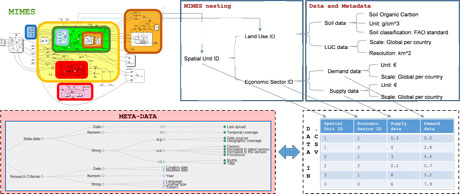by Benedetto Rugani, Paulo Carvalho and Benoit Othoniel
When defined, metadata information that accompanies Big and Open Data (OD) datasets may be hard to understand and exploit. A visual approach can support metadata re-use in integrated ecological-economic modelling. A method that allows specific model datasets to be regularly and consistently updated may improve their readability for use in the Life Cycle Assessment (LCA) modelling of ecosystem services.
“Ecosystem services” is a term used to describe the benefits humans get from the Earth’s natural capital (e.g., forest biomass, water purification, soil quality, etc.). These flows reflect the interaction among all capitals of biosphere and anthroposphere. Complex interdisciplinary modelling is necessary to study these interactions and to assess ecosystem service values, thus a big data (BD) collection and elaboration effort is often required. BD have also been put to good use in the Life Cycle Assessment (LCA) framework [1], which is one of the most robust and commonly applied methodologies to evaluate the impact of human activities on ecosystems. However, there is no consensus on how to evaluate ecosystem services in LCA. This is due, in part, to the lack of consensus on the standardization and use of data and models, which can be broadly retrieved from OD sources.
The aim of the VALUES project (see at: http://www.list.lu/en/project/values/) is to develop a novel approach to simulate the value of biodiversity and ecosystem services within the LCA methodology. This work is being conducted by researchers within the RDI Unit on Life Cycle Sustainability and Risk Assessment (LiSRA) at the Environmental Research & Innovation (ERIN) Department of the Luxembourg Institute of Science and Technology (LIST). The team is adapting MIMES (Multi-scale Integrated Model of Ecosystem Services) [2] to the LCA framework. The main challenge is to model the nexus among multiple elements of the biosphere and the anthroposphere at different geographical and temporal scales, generating a holistic integrated representation of the local (e.g., country scale of Luxembourg), multi-regional (e.g., Europe) and global relationships between economic and ecological systems.
One of the major tasks of VALUES is to solve the problem of collecting, elaborating, managing and running a large amount of data (mostly OD), such as georeferenced information, and ecological/biophysical and process life cycle data. These need to be stored in the model to describe all the relationships between modules, sub-models and compartments of MIMES, e.g., to describe the interactions between the emission of pollutants and wastes from energy production or transport systems and their effects on the receiving ecological and human compartments, i.e., air, soil, water, and the human body.
The global version of MIMES already contains thousands of variables and process modelling parameters. However, improving the existing MIMES relationships and model transparency requires the incorporation of additional “heavy” datasets and metadata layers, respectively. As a consequence, the number of model reference variables is expected to increase in the range of 40-70% by the end of VALUES in 2017. On one hand, a certain level of model aggregation needs to be maintained or achieved to avoid computational issues. On the other hand, a large amount of datasets and database sources needs to be harmonized in one unique modelling framework.

Figure 1: Simplified approach for data management in the VALUES project.
As shown in Figure 1, the complexity of sub-models in MIMES can easily be increased when amplifying the resolution of assessment or the detail of process connections. Moreover, a large amount of metadata information must be stored in the modular system of compartmental relationships across variables, and then regularly upgraded with information collected from the same or other BD-like sources (e.g., statistical datasets, climate measurements, biological engineering databases). Most of the metadata information is then screened, modified and linked to upstream .CSV files containing the original input datasets necessary to run the model.
However, metadata is often missing or difficult to understand, posing additional problems related to the transparency of the modelling approach. These complications limit the usability of the data, and the reproducibility of the models that need constant updates. When defined, metadata information may be set up in different languages, under various data types and using different keys to represent the same meaning (e.g., bottom-left box in Figure 1 represents the metadata existing for the EU dataset on the association of species and habitat types to ecosystems: http://www.eea.europa.eu/data-and-maps/data/linkages-of-species-and-habitat/). The LiSRA and e-Science RDI Units of ERIN/LIST are currently working to overcome such data modelling obstacles [3].
By considering MIMES as test-bed case to develop a methodology of OD management and metadata visualization, VALUES can be optimized to guarantee the success of modelling outputs and increased system transparency. Furthermore, the use of OD collection and visualization techniques in VALUES can support future expansions and cross-fertilizations of such IT approaches to access BD within the broader LCA framework. This project represents a tangible example that may pave the way towards more effective and transparent management of metadata in complex life cycle process unit databases, making a valuable contribution to current state-of-the-art practice and tools for LCA [1].
Links:
http://www.list.lu/en/project/values/
http://sourceforge.net/projects/mimes/
http://www.simulistics.com/
References:
[1] J. Cooper, et al.: “Big Data in Life Cycle Assessment”, Journal of Industrial Ecology, vol. 17, pp. 796-799, 2013.
[2] R. Boumans et al.: “The Multiscale Integrated Model of Ecosystem Services (MIMES): Simulating the interactions of coupled human and natural systems”, Ecosystem Services, vol. 12, pp. 30-41, 2015.
[3] P. Carvalho, P. Hitzelberger, and G. Venturini: “Understanding Open Data CSV File Structures for Reuse”, in ERCIM News 100 (January 2015), ed ERCIM EEIG, 2015, p. 36.
Please contact:
Benedetto Rugani
Luxembourg Institute of Science and Technology (LIST)
Tel: +352 2758885039
E-mail:











